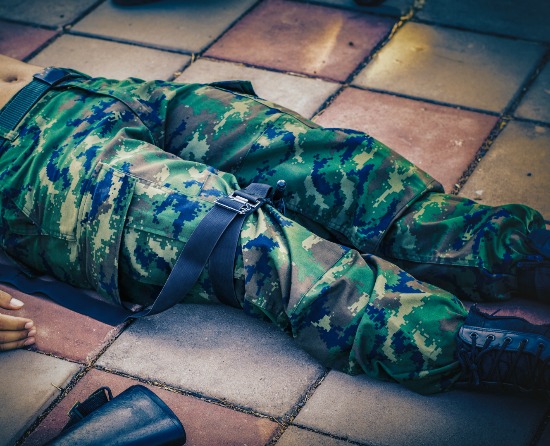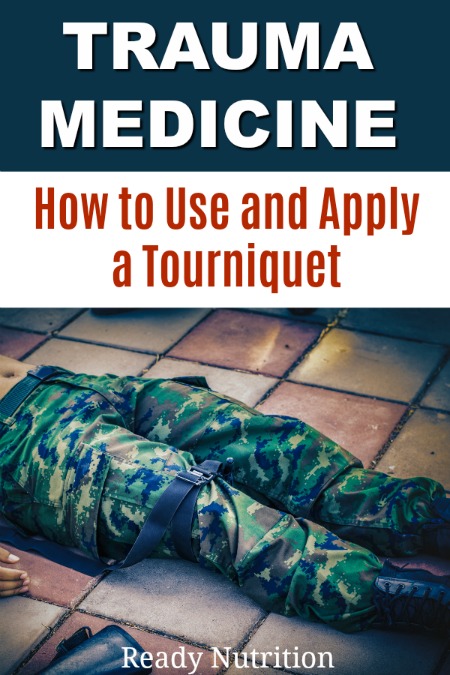
First, the proper use of a tourniquet is to stop arterial bleeding on a limb – when an artery is severed and simply applying pressure while waiting for a clot to form won’t work. Proper use of a tourniquet could ensure the saving of a limb, but proper care needs to be taken as well, as misuse could result in the loss of a limb. And a helpful hint: you may need more than one, so add a few to your supply!
Primary Principles of Immediate Response
Wounds that can cause death are often located in the arms and legs, the torso junctional (located in the armpits, groin or neck), and the chest or abdomen which could be an indicator of internal bleeding.
There are a few primary principles to consider when you are controlling a life-threatening hemorrhage. The first of which is to ensure your own safety. Make sure you are out of danger and are in a safe location before you render aid. If you are out of danger, begin using the ABC’s of Bleeding Control:
- A-Alert 9-1-1
- B-Locate the bleeding
- C-Compress and apply pressure to wound
If there is life-threatening bleeding to an arm or leg, you want to apply a tourniquet.
Types of Tourniquets
The common tourniquet used by the army can be purchased on Amazon. It’s called the Combat Action Tourniquet (CAT tourniquet) and is made for a single-handed (meaning you could use this on yourself) application. The tourniquets run around $30 and aren’t practical for a civilian to carry around in his pocket every day, but could be a vital addition to a prepper supply. The Mgrowth Rescue Tourniquet is a less expensive option, or you could just add a complete trauma kit, such as the Ever Ready First Aid Trauma Pack, which contains other items such as Quickclot, to stop the bleeding quickly and effectively.
Alternatives To Tourniquets
You can also use some critical thinking skills if a tourniquet is needed and you don’t have one on hand. Look around you; there are tourniquets everywhere. Your belt, the laces on your shoes, or a long sleeve shirt could be tourniquets. A bicycle inner tube, a backpack strap, or a woman’s bra could be used as tourniquets also. You can fashion this lifesaving device out of almost anything. You could even consider using a rope or a survival bracelet first if you have them handy. In order to tighten your tourniquet, you’ll also need a torsion device. This can be anything long and stick-like. If you’re in the woods I recommend using, well, a stick. If there are absolutely no sticks or stick-like objects around you, then close your knife’s blade, or put the sheet on it, and give it up for a good cause. It’s now your torsion device.
An important note to remember is that a tourniquet will not help in the event of a snake bite and you should never attempt to use one to restrict the blood flow to the area. In case of a snake bite, mark the area so you know how much worse the spread of venom is getting and keep the victim as calm as possible. Never attempt to cut out or suck out the venom as seen in movies either. In this case, you should have a snake bite kit in your first aid kit as part of your survival gear.
Everyday tourniquet use (a first responder may not be available in a SHTF situation, so please keep this in mind).
- Make sure you wear gloves if you have them to create a blood barrier between yourself and the victim.
- In some cases, you need to remove the clothing covering the injury so you’ll know exactly what you are dealing with.
- Apply direct pressure to the wound site. Use gauze on the wound during this step if it’s available. If there is no gauze, use a towel or washcloth or a rag torn from a shirt. Non-sterile bandages can cause infection, however, experts agree that it’s better to stop the bleeding first.
If the pressure you’re applying does not stop the bleeding, and the dressing becomes soaked with blood, then you will need to apply a tourniquet.
- Tourniquets are ONLY used on limbs! Never on a neck! A tourniquet won’t help with bleeding on the torso. Keep the tourniquet high and tight. The purpose of a tourniquet is to shut down the artery.
- Twist the torsion device in ONE DIRECTION until the bleeding stops and then secure the tourniquet in place.
- You need to then check on the person who you’ve just applied the tourniquet to. Make sure they are still breathing.
- Set a timer so that when (if) a first responder arrives they can be told how long the tourniquet has been in place.
It is important to know how to properly use a tourniquet, and properly assess a person for shock, you should consider taking a class and practicing how to apply one. It could be a life-saving skill, and you will likely want the confidence to use the tourniquet if necessary.
Applying a Tourniquet For a Massive Lower Extremity Bleeding
Applying a Tourniquet to an Upper Extremity
Recent research in military hospitals in Iraq and Afghanistan has shown that, contrary to popular belief, using a tourniquet doesn’t guarantee limb amputation or even nerve loss. In fact, researchers found that among patients who had a tourniquet applied to a limb before arriving at the hospital, only 0.4% of them underwent an amputation and usually the reason they got an amputation had nothing to do with the tourniquet. When it comes to nerve damage, only 1.5% of patients who needed a tourniquet suffered any kind of permanent nerve damage. Based on this newfound knowledge, many civilian EMS teachers and practitioners are starting to encourage tourniquet use much sooner.
Skills such as applying a tourniquet could mean life or death for the person being saved. Please ensure you get training if you feel it’s necessary an make an effort to properly stock your prepping supply because let’s face it: none of us knows what can happen when the SHTF!


You should have the illegal alien hero from the Boston Bombing teach how to do a tourniquet. Put him in a wheel chair and tie a bandana around one leg and wrap a shoe lace around the other one and run. No blood trail and still conscious. B.S.!!